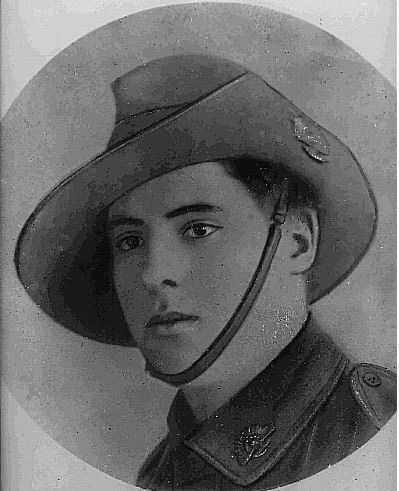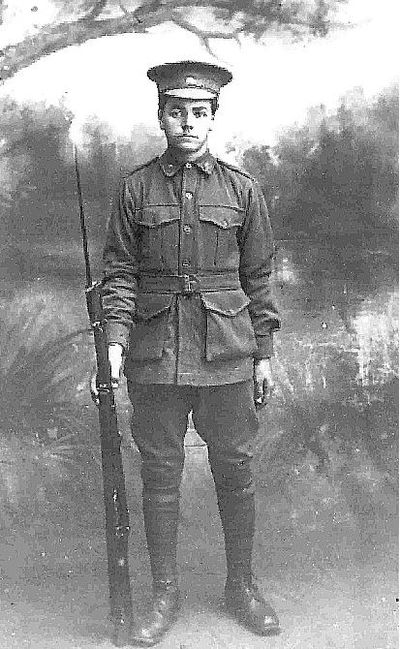George Henry Holroyd
From Our Contribution
 Courtesy Pickering Brook Heritage group | |
 | |
| Personal Information | |
|---|---|
| Date of Birth | 24 Aug 1899 |
| Place of Birth | Greetland near Halifax, Yorkshire, England |
| Death | 8 Sep 1979, aged 80 |
| Place of Death | Pickering Brook, Western Australia |
| Age at Enlistment | 18 years (actual age 17) |
| Description |
5'4½" (1.64m) tall ; 128lbs 58.06 kg ; fresh complexion ; brown eyes ; brown hair |
| Occupation | Blacksmith |
| Religion | Methodist |
| Address | Greetland House, Gosnells, Western Australia |
| Next of Kin | Father , Mr James Edward Holroyd |
| Military Information | |
| Reg Number | 6329 |
| Date of Enlistment | 4 Sep 1916 |
| Rank | Private |
| Unit/Formation | 28th Battalion, 18th Reinforcement |
| Date of Embarkation | 29 Dec 1916 ‒ 3 Mar 1917 |
| Ship Embarked On | HMAT A34 Persic |
| Date of Return | 12 Dec 1918 ‒ 18 Jan 1919 |
| Ship Returned On | HMAT A71 Nestor |
| Fate |
WIA 3 Oct 1918 Beaurevoir Line Returned to Australia |
| Monument |
Gosnells Road Board Honour Roll Gosnells Primary School Honour Roll Gosnells Ward Honour Roll |
| Medals |
British War Medal Victory Medal |
Pre War
George arrived in Australia on 23 Nov 1912 from England with brother Ernest (17) and sister Annie (20). On arrival they moved to live with relatives at Greetland House, Gosnells.
War Service
After 10 days basic training at Blackboy Hill camp, George was allocated to the 18th reinforcement draft for the 28th Battalion. He was briefly earmarked to move to the 7th draft for the 5th Pioneers, but a week later he was back with the 28th Battalion group. On 29 Dec 1916 he and his group sailed from Fremantle aboard the HMAT A34 Persic for England where he disembarked at Devonport on 3 Mar 1917. On arrival in England he was sent to the 7th Training Battalion at Rollestone where on 12 Mar 1917 he was admitted to the Fargo Military Hospital with pneumonia until 2 May 1917. On 17 May 1917 he was charged with having been AWOL from midnight 15 May until 9:00pm on 16 May 1917. Awarded 1 day confined to camp and the loss of three day's wages.
George proceeded overseas to France through Southampton on 25 Sep 1917. On 6 Nov 1917 George was temporarily detached to the 2nd Mobile Veterinary Section, returning to the 28th Battalion on 17 Nov 1917. George was granted leave to the UK from 7 - 25 Sep 1918.
During fighting around the St Quentin Canal, and near the Masnieres - Beaurevoir Line on 3 Oct 1918, Ernest was wounded with a shrapnel wound to his left arm. The battalion's losses for the day were 1 killed, and 70 wounded.
Seen by the 7th Field Ambulance, he was passed on the same day to the 53rd Casualty Clearing Station before being admitted the next day (4 Oct 1918) to the 1st Australian General Hospital in Rouen. Evacuated to England on 5 Oct 1918 he was admitted to the Town Hall Hospital in Torquay on 6 Oct 1918. Discharged on 9 Nov 1918 and granted furlough he reported to the No.1 Command Depot in Sutton Veny on 25 Nov 1918. A Month later, on 12 Dec 1918 he was on his way home to Australia aboard HMAT A71 Nestor where he was disembarked at Fremantle on 18 Jan 1919, and was discharged by the 5th Military District on 21 Feb 1919.
Post War
Electoral Roll entries : 1924 - 1968 Pickering Brook road, Pickering Brook, quarryman. With his brother Ernest, George purchased land in Pickering Brook under the "Returned Soldier Settlement Scheme" in 1924. Their house is now heritage listed on the Kalamunda heritage Inventory. The brothers never married and lived at the house with colleagues from the Boya Quarry who had nowhere else to live.
Notes
George increased his age from 17 to 18 on enlistment.